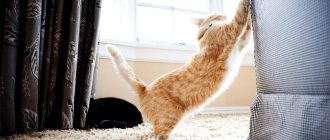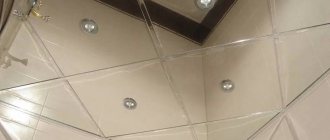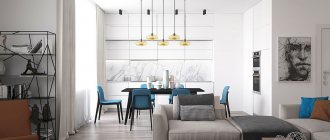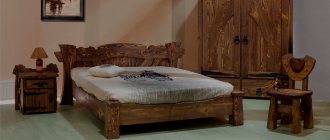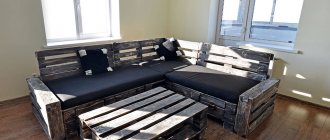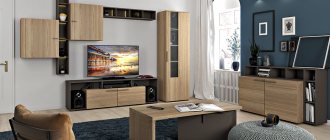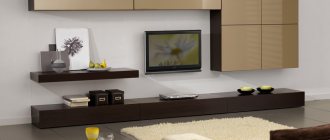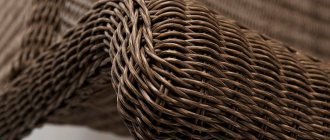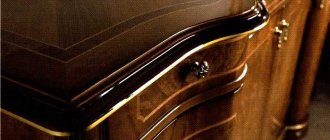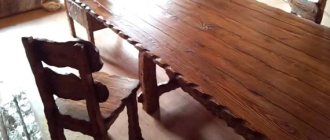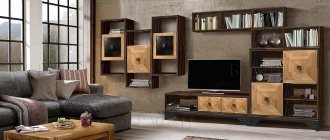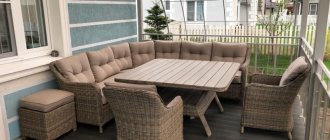Pros and cons of film facades
In addition to the variety of appearance, the advantages of film for MDF facades include:
- low cost;
- simple application technology;
- practicality in operation;
- high moisture resistance;
- good resistance to ultraviolet radiation (fading);
- environmental Safety.
The disadvantages include:
- Relatively low resistance to mechanical stress. The surface is easy to scratch.
- Low upper threshold of operating temperature (about 80°). Therefore, film for a kitchen table is not the best option - even a cup of hot tea can leave a “whitish” mark.
- It is impossible to restore the surface by grinding or polishing.
Kitchen furniture has the highest risk of damage - this is where it experiences high mechanical and thermal loads. But all these shortcomings are compensated by the possibility of updating using self-adhesive film for the kitchen.
Paint
Paint will be a real savior in furniture restoration. Before applying paint, sand the surface and coat with primer.
You can simply paint the cabinet in 1-2 colors, or you can paint a real picture on it. If you don’t have enough artistic skills for painting, you can make a drawing using a stencil. Geometric lines and shapes can be easily created using masking tape - it will serve as a smooth border for the paint. And for more complex patterns and pictures, the stencil will have to be made specially.
We talked about ways to transfer images to surfaces here: “The Happiness of Drawing on Walls.” And this link contains detailed instructions for using stencils: “Experiment: painting a wall using a stencil.”
What are MDF facades in PVC film?
PVC film for furniture facades is a polymer material made of polyvinyl chloride, 15-80 microns thick, used for covering furniture made of MDF and chipboard, as well as for self-gluing.
Furniture facades are usually made of wood or wood materials: solid hardwood, chipboard and MDF (. There are also “curvilinear” or “radial” doors of cabinets and cabinets, but this is a separate category, although in this case plywood is bent on the matrix, special grade MDF or gluing together several sheets of fiberboard.
Each type of facade has its own “set” of decorative processing options. The most limited choice for chipboard is only lamination at the factory, followed by gluing the edges of the blanks at the ends. Chipboard facades are straight slabs that cannot be milled, sanded or painted.
And MDF facades have the most possibilities for finishing and processing. They, like chipboard, can be laminated at the factory and imitate any “smooth” or “voluminous” texture. The slabs can be milled, sanded, painted, and enamel applied. But the most economical option for decorative finishing is gluing MDF parts with PVC film.
In factory conditions, facade production looks like this:
- cut out the part;
- if necessary, mill a three-dimensional pattern;
- polish the surface;
- pressed with PVC film.
Types of self-adhesive PVC film
The film is responsible for the decorative appearance of doors and drawer front panels. She may be:
- matte, glossy, semi-matte;
- monochrome, with a geometric or abstract pattern;
- with imitation of the texture of stone or wood cut;
- with mother-of-pearl or metallic shimmer;
- with sparkles or flocks (colored splashes).
Such wide decorative possibilities are one of the main reasons for the popularity of MDF facades in PVC film.
Self-adhesive decorative film consists of three layers:
The front layer is the polymer film itself.
The second layer , which is responsible for adhesion to the surface of the part, is a synthetic rubber or acrylic adhesive for PVC film and MDF facades.
The third layer is siliconized paper, which protects the glue during transportation and storage of the kitchen film. The paper is removed immediately before pasting.
According to production technology, adhesive film for the kitchen comes in two types:
The first type is usually used on MDF kitchen facades with a “smooth” surface.
Molding is used for covering MDF boards with three-dimensional relief with film. It stretches well even without preheating, and does not shrink after drying.
Criterias of choice
The choice of film for covering furniture is based on practicality, durability, appearance and price. All these characteristics directly depend not only on the production technology, but also on the ratio of the components used.
Polyvinyl chloride is a synthetic durable substance, practically not subject to mechanical damage, and is not afraid of temperature changes and direct exposure to water. Using it as a base makes PVC furniture films the highest quality of the entire line of products in this series. The PVC base can be formed into a structure, resulting in coatings that imitate wood, stone, fabric, etc.
Pasting furniture with vinyl film will give the product strength no worse than PVC, but the more delicate structure of vinyl means it can be used to create smooth, glossy canvases. These types of materials need to be glued to prepared, leveled facades. More expensive specimens have a higher percentage of plasticizers, which make the base thicker.
There is a category with a thermal protective layer for use near heating appliances and heating systems, as well as with increased moisture resistance.
It is important to consider the surface of the furniture that will be restored. It is more appropriate to cover rough, uneven furniture with a single-layer cast film
It is perfect for carved areas.
Well, last, but by no means least important, is the aesthetic component of the issue: color, structure, motifs of images. The availability of the material allows you to experiment without fear of an unsuccessful result
But it’s better to think about the style of the interior and the possibility of using one or another coating.
How to choose PVC film for MDF facades
There are two selection criteria:
- compliance with interior design requirements;
- minimizing waste when cutting and fitting.
The first criterion determines what kind of adhesive film with a pattern should be for the kitchen. For traditional interiors, materials that imitate the texture of wood are usually chosen. Whether these shades are light or dark is determined depending on the finish of the walls and floors, the size of the room, the location of the kitchen and the level of natural light.
The classic option is to decorate facades with white film.
Material characteristics
Furniture film helps to visually refresh furniture panels that have become boring over time in a short time. With the help of simple manipulations, the procedure can be done with your own hands in a few hours. To do this, you only need the material itself and sharp scissors or a construction knife.
Today, the range of this raw material occupies a leading position among other methods of furniture restoration. Using the material, you can bring any design solutions to life without spending a lot of money.
The popularity of using self-adhesive is due to its following advantages:
- the material is supplied in rolls, making it easy to cut rectangles and squares of the required dimensions;
- the film helps protect furniture from future scratches and chips, and if they do appear, replacing the material will not be difficult;
- self-adhesive film will help save the family budget: you won’t have to purchase a new set if it is possible to update old products;
- no additional tools are required for work;
- well suited for kitchen furniture, protecting it from grease, dirt and other damage;
- the material is easy to clean, self-adhesive compounds can be treated with detergents and gels.
The raw material consists of several layers: front, adhesive, protective. Each of them performs its own function. The very first layer, the front layer, is made from different types of materials:
- polymer film - represented by a self-adhesive type of vinyl, which perfectly covers surfaces. She looks very beautiful on furniture, and her decorative abilities are invaluable. In addition to vinyl, PVC or polyester is used;
- foil - used for lining less used pieces of furniture, most suitable for wall cabinets;
- paper - paper-based material can be glued to the ends of the shelves, since such a film does not withstand constant mechanical stress.
Decorative film can imitate a large number of surfaces: leather, wood, natural stone, ceramics, tiles and fabric. Thanks to this, it has a wide range of applications not only in updating facades, but also in ordinary decor.
Depending on the material of manufacture, self-adhesive film is divided into:
- single-layer roll products - produced on the basis of polymers, additives in the form of plasticizers, which give the raw material strength: all components are mixed together and flat rolls are formed by extrusion;
- two-layer models - in this case, two fabrics are used in production: the base and the surface; such material is technically worse than its single-layer counterpart.
Anyone can glue furniture on their own; no special skills are required. Before you start work, select the surface structure of the film; it can be glossy, matte, transparent, mirror and holographic
Each type is used in individual cases, so it is important to determine in advance the purpose of the raw material
Covering kitchen units with film at home
To successfully cover a kitchen façade or splashback with MDF at home, you need to carry out the preparatory stage correctly. It consists of the following points:
- Preparing facades for pasting . To improve the adhesion of the adhesive base to the part being restored, it must be cleaned of dust and dirt and degreased using detergents based on alcohol or quaternary ammonium. If there are deep scratches and chips, they need to be puttied.
- Preparing the walls . To stick it as a kitchen apron on a plastered wall or drywall, the surface of the base is puttied, sanded and coated with a primer. Painted walls are cleaned of dust and degreased.
- Preparation of materials . Before starting work, the film for the kitchen facades and apron is unrolled, the information on the back is read, and patterns are made in accordance with the marking grid and the dimensions of the parts (surfaces).
Note. To replace the film on a kitchen facade with a relief surface, a new blank must be cut with a small margin. It is better to trim off the remainder of a couple of extra centimeters than to cut out a new pattern if there is not enough material.
The gluing process occurs for each part separately.
Important! It is necessary to ensure that when pasting the facades of one pencil case or the door of a bedside table and a drawer above it, the drawings of the upper and lower parts fit together in direction and, at least approximately, coincide in step.
The work is carried out in the following order:
- They try the pattern on the part and make sure that it fits neatly in place.
- Remove the edge of the pattern by approximately 5 cm from the protective paper. And carefully align it with the edge of the part, trying to avoid distortion.
- Gradually remove the paper backing and roll the pattern onto the surface of the facade. The principle of pasting is similar to working with wallpaper - smoothing is carried out from the center line to the edges, trying to drive the “bubbles” beyond the border of the part.
- To paste over relief parts with internal corners and edges, the film can be slightly heated with a regular hairdryer to make it more flexible and “softer”.
- If a fold or crease is formed, or if the pattern is shifted to the side relative to the axis (border) of the part, the façade film for the kitchen must be carefully separated from the surface and re-glued.
Important! The glue is not fast-drying - its polymerization time is long enough to correct errors in laminating MDF with PVC film.
Video on how to cover a kitchen unit yourself with film below:
Watch the video of how to cover a kitchen façade with self-adhesive film with printing:
Step-by-step instructions for gluing
So, the choice has been made, the self-adhesive tape has been successfully purchased in the store (for this purpose, go to any construction supermarket), and there is a mood to breathe new life into the “ruined” kitchen. It's just a matter of small things - actually, the pasting:
- remove all removable parts (fittings, doors);
- carefully sand all problem areas on them, having previously puttyed them; wash them with soap and water and degrease the surface - for this you can use a regular solvent or acetone;
- wait for the fat-free base to dry and take all the necessary measurements, consistently adding at least 1 cm to each segment (your safety “reserve” in case of a beveled corner);
- turn the film over and apply markings - most options have a millimeter grid, which makes the task much easier;
- cut off the necessary fragments with a stationery knife - scissors will also cope with this task, but they leave unevenness and ugly scraps, so it is better to prefer the first option;
- if you cut a drawing, then do it along the front part - so as not to miss and save the image;
- begin to sequentially cover the façade and countertop of the kitchen unit with self-adhesive film, separating the protective paper by no more than 4-5 centimeters and placing the adhesive side against the surface;
- From the middle to the edges, carefully level the film with a soft cloth or silicone spatula, avoiding the appearance of unpleasant bubbles - if you do everything correctly, excess air will escape through the edges of the facade;
- glue the joints with an overlap of at least 1.5 centimeters;
- Before you start gluing the fittings, carefully use a knife or any sharp object to make holes in the films at the locations of the joints.
That's probably all. There is no need to rush anywhere - and everything will work out in such a way that even the most picky eye will be satisfied with what it sees.
Attention: all stages must be performed in the brightest possible light. This way you will significantly reduce the likelihood of missing some defects on the surface along the way.
Features of caring for film facades
Caring for film facades is simple. Both dry and wet cleaning are suitable for them.
Dry cleaning is carried out using soft wipes for the care of delicate surfaces. Large areas can be cleaned of dust using a vacuum cleaner and a long-bristle brush attachment.
Wet cleaning is carried out with warm water and soapy water. Heavy contamination is removed with household detergents based on alcohol or quaternary ammonium.
Important! It is prohibited to use abrasive cleaning agents, hard brushes, scrapers or any other devices for mechanical cleaning - they leave scratches on PVC film facades.
Anyone can reupholster kitchen facades with film - no special tools or professional skills are needed for this. The main thing is to be careful and attentive to details. As a result, the old kitchen will be transformed and will last for several more years.
Partial restoration of kitchen facades allows you to update the interior, make it fresher, and visually attractive. Replacing a kitchen unit can be quite expensive, so you can only update the facade. This restoration technology will help change the appearance of the furniture, while its main parts will remain old, which will significantly save on replacing cabinets.
Wardrobe pasting
Pasting the cabinet can be done using the wet or dry method. The choice of method will affect the result.
Dry pasting method
Thus, the dry method is used if the kitchen facade is peeling off in small areas, as well as in the case of applying decorative details on the corners of furniture or uneven areas. In this case, a small part of the protective backing is separated, which will free up the base. After this, the new coating material is applied and leveled.
Wet method
If it is necessary to cover an old cabinet with film, the wet method of laying the decorative coating is used. In this case, the material is fixed on a moistened base, which will allow for correction during work. To moisten the adhesive mixture applied to the base, use a spray bottle. The backing must be completely removed. The inside of the product is wetted with a soap solution. To prepare it, dilute 10 milliliters of liquid soap or other detergent in a liter of water.
When using the wet method of covering a cabinet with self-adhesive film, it is important not to over-wet the surfaces. Significant moisture causes the canvas to slip and slows down the gluing process.
The film is placed on the desired area of the furniture, the canvas is secured by moving the roller from the center to the edges of the product. The remaining solution should evaporate within 2 days from the moment of application. After this, the canvas with the pattern is processed again with a roller. A similar sequence of work is used for gluing side walls and facades.
Benefits of façade renovation
Self-adhesive film was used to restore the facades. There are times when it begins to come off: if the MDF film has peeled off in the kitchen, you should not rush to replace it with a new one. The film often peels off due to humidity, temperature changes, steam, and the use of low-quality glue.
You should not be surprised if peeling occurs quite quickly, even during loading after manufacture or when the product has a short lifespan. The film peels off from MDF facades for the following reasons:
- The glue is not applied to the entire surface. When the substance is applied manually, the worker often misses sections of the product and the film does not stick to them. You can solve the problem by using colored glue.
- Using a cheap, poor quality substance. Quite often a two-component polyurethane composition is used. It is quite difficult to mix it in the correct proportion, so the glue hardens incorrectly and does not hold well, and bubbles may appear on the film.
- Using expired glue. When using such a material, the film will stick, but will peel off fairly quickly.
- Insufficient temperature during gluing, as a result of which the connection did not go well enough. There can be many reasons: poorly heated film, the vacuum was applied too early, the adhesive layer was thin, the workpieces for the facades were cold, it could have been cold in the workroom, the film was not pressed well enough, due to a weak vacuum supply, the wrong adhesive was chosen, the composition of which does not come into contact with a specific film. The facades themselves could also be used incorrectly: for example, they were located next to heating appliances, a stove, or sources of moisture. Before purchasing, it is important to find out how to properly care for furniture and for what conditions it was made.
How to fix the problem?
If the film on the facade of the MDF kitchen has peeled off , you need to carefully spread it with glue from the edge and press it down. There is a chance that the film will take the desired shape. Another way to restore the coating is to use an adhesive membrane. To do this, you will need to lay the boards on a dry and flat surface, for example, on a table, cover them with a membrane, and use a vacuum. The membrane should tightly cover the facades. If you want greater reliability, you need to use high-quality glue and heat the material so that it can be activated. Warming up should be done evenly. This method is suitable only for unmilled facades: if the surface is uneven, the membrane will not stick and will quickly peel off. Therefore, it is so important to correctly restore kitchen facades while observing certain conditions.
Using heating devices
If the PVC film peels off from MDF kitchen facades, you can try replacing it with a new film or gluing the old material in place using available electrical appliances. This could be an iron, a powerful home or construction hair dryer. The film needs to be carefully warmed up: it should become quite soft and blurry, but not start to melt. If you have something to try, use these pieces or on an inconspicuous place on the façade. The device is pressed against the edge that is not glued for a few seconds. The film should stretch, the glue should warm up at this moment, and the material should protrude towards the back side of the facade and adhere firmly. If this can be done, then it will be possible to glue the entire facade in this way, in places where the film has retreated.
Advice: the film itself cannot be heated with a hairdryer at close range, as this will curl it and be damaged.
This DIY restoration of kitchen facades requires some skill, but is quite simple to perform and does not require the use of expensive tools or materials. If the inside and corners are poorly glued, you can use a metal rod comparable in size to the frame. First you need to warm it up. For this, you can use, for example, a gas burner.
Restoring coating using friction
Restoring kitchen facades from MDF using this method does not require any available tools at all. In order to glue the separated section of the film, you need to cover it with a rag and start rubbing it with your fingers, pressing the film. If there is adhesive underneath, the temperature from friction in a small area will be enough to activate a chemical reaction and cause the film to stick.
Advice: this method should be used carefully, as there is a high risk of damaging the film, exposing its edge or removing the top layer, which will ruin the appearance of the coating.
Application of glue
Restoring a glossy kitchen can cause some difficulties, since gloss does not tolerate strong physical impact, which is why it should not be roughly rubbed with your fingers or heated closely with any appliances. You can try a safer method - gluing the separated film using “Moment”. Most often, such a film peels off in the kitchen, since it is not affected by hot steam. It is necessary to restore the coating as quickly as possible, otherwise the furniture itself will be damaged. The glue must be applied to the untreated area of the facade and to the film itself along the edge so that it can isolate the seam from negative influences. All this must be done carefully, as the glue easily sticks and gets dirty.
Common mistakes
Sometimes, even after finishing the furniture, bubbles, folds and other defects may appear that were made during work. Correcting defects is not possible in most cases, so the film must be removed and the procedure will have to be repeated again. When doing the work yourself, you can make the following mistakes:
- Before gluing the material to the surface, it was not treated with a cloth or brush. The important point of removing dirt and dust is to ensure a smooth coating, and the presence of small dirt particles underneath will spoil the appearance;
- the cut piece was not enough to cover the shield. This happens if you don’t take a few centimeters in reserve when cutting. Usually it is calculated at 2-3 cm, which can easily be measured on the back side of the material, where the measuring grid is located;
- the drawing on the plane does not match. Answering the question: how to properly glue a film that imitates natural materials, it is worth emphasizing that it must be cut at the seams - then there will be no problems with the pattern shifting;
- Furniture defects are visible under the coating. The reason for this error is poor preparation of the base or the use of too thin material. If the furniture is old enough, then it is better to use rolls with a thicker front layer. Before gluing self-adhesive film on furniture, all damage must be removed.
To do the job efficiently and to paste the furniture yourself without any defects, follow the technology for applying the material. It is better to pre-twist all the fittings, and process the elements of collapsible structures separately. Properly done work will delight all family members with a beautiful updated look of furniture products.
